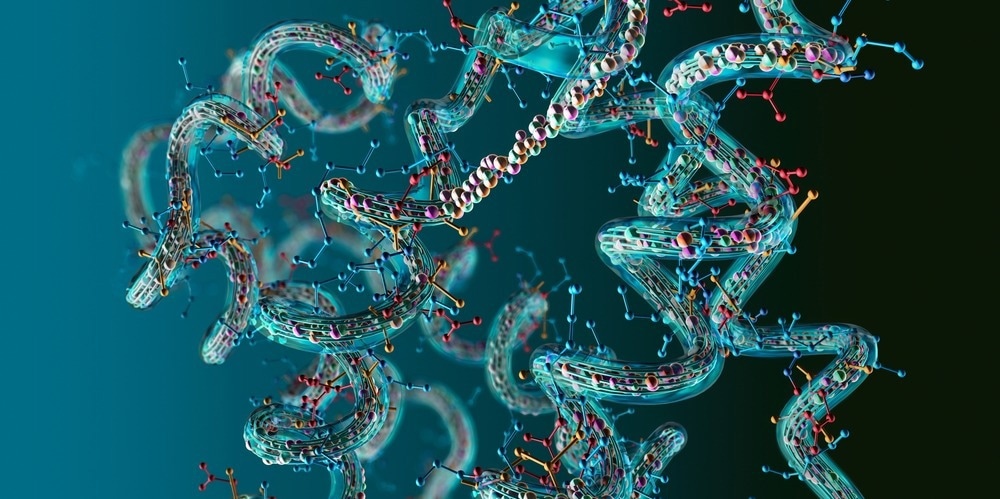Nuclear magnetic resonance (NMR) spectroscopy has been a pivotal technique for studying structural biology.1

Image Credit: Christoph Burgstedt/Shutterstock.com
What has made NMR such a useful tool for the study of proteins is its ability to capture structural information on the atomic arrangements and orientations within the protein and dynamical information on how the proteins fold, unfold and deform on interactions with other species.
Such experiments can also be performed in solution, closer to the native environment of biological species than the crystal structures used in crystallographic experiments.
The large number of atoms and the complexity of protein structures can make them challenging to study with spectroscopic techniques. What is commonly done with NMR for structural biology studies is that a number of different experiment types that are sensitive to different aspects of the protein structure are used.
For example, correlation spectroscopy (COSY) NMR experiments are very valuable in the recovery of information on proton-proton couplings and the through-bond interactions, which can help refine information on the relative positions of the protons in the structure and also be used for quantitative analysis.2
On the other hand, nuclear Overhauser effect (NOESY) experiments are sensitive to through-space couplings and are very useful for understanding the three-dimensional structure of the protein and the overall stereochemistry.3
Another technique that is widely used for structural biology studies is heteronuclear single quantum coherence (HSQC), which can be used to evaluate correlations between two NMR-active species, typically protons and carbons or nitrogens.4
HSQC is typically used to determine the backbone resonances in proteins as well as a mean of assessing post-translational modifications, which is another laboratory technique to help with structural assignment in proteins.5
Data to Structure
Despite the wealth of techniques out there, converting between NMR data and a full protein structure is not always trivial. What is normally done is the results from many different experiments are brought together and the NMR data is used to impose a series of angle and distance constraints on the structure to be solved.6 Sometimes, algorithms are used to trial a large number of structures to see which offers the most consistent results with the observed data.
Often, NMR data is used alongside other structural biology techniques, such as cryo-EM and X-ray crystallography.6 While the data is not always directly comparable, as the measurements may be made in different phases, the direct structural information from spatially sensitive methods can be used to help refine NMR assignments.
Some of the key advantages of NMR methods over other techniques are the smaller sample amount requirements and that measurements do not require sample preparation such as crystallization, which can be problematic for some proteins.
Protein Structure and Folding
Video Credit: Amoeba Sisters/YouTube.com
Commercial Relevance
One of the major commercial uses of NMR in structural biology is to study structure-activity relationships by elucidating both protein structures and optimizing drug design by looking at drug-protein interactions.7 NMR is also often used as quality control to assess whether a drug is sufficiently pure or has multiple conformers that might change the types of interaction within the body.8
Verifying the exact structure of drugs is very important, as drugs that are chemically identical but are not enantiomerically pure can lead to unwanted interactions in the body. The example of thalidomide is one case where a drug sold as a racemic mixture, with both enantiomers present, had significant and unwanted side effects due to the presence of one enantiomer.
NMR can be used to refine chromatography-based purification approaches for drugs by providing information on the intermolecular interactions between the drug and other species. Information on the through-space couplings can be used to measure how strongly different targets will interact and be used to optimize the stationary phases used for drug separation.
Many diseases are caused by issues with protein structures. The types of deformations may be an issue with how the protein folds or unwanted intramolecular interactions that cause the protein to essentially be the wrong shape for its function.
The basis of many therapeutics is controlling protein-protein interactions. What NMR can do is help identify which sites on the protein might be good targets for a small therapeutic to interact with and how the two proteins may interact and bind.9
The more in-depth information recovered on the types of intermolecular interactions from NMR means that drug design and modeling can go beyond predicting structures that seem to be good fits on the ‘lock and key’ model of interactions, where simply the overall shape of a target determines whether it will fit in and interact with a specific site.
Overall, the versatility of NMR and the number of different pulse sequences and experiment types alongside advanced labeling techniques have made NMR an invaluable tool in understanding both the static structures of proteins, their dynamical behavior and interactions with other species.
Sources:
Nilges, M., & Markwick, P. R. L. (2008). Structural Biology by NMR : Structure , Dynamics , and Interactions. PLoS Computational Biology, 4(9), e1000168. doi.org/10.1371/journal.pcbi.1000168
Wurhrich, K. (1989). Protein Structure Determination in Solution by Nuclear Magnetic Resonance Spectroscopy. Science, 243(4887), pp. 45–50. doi.org/10.1126/science.29117199
Aliphanahi, B., et al. (2013). Determining Protein Structures from NOESY Distance Constraints by Semidefinite Programming. Journal of Computational Biology, 20(4), 296–310. doi.org/10.1089/cmb.2012.0089
Yee, A., et al. (2001). An NMR approach to structural proteomics. Proceedings of the National Academy of Sciences, 99(4), 1825–1830. doi.org/10.1073/pnas.042684599
Kumar, A., et al. (2020). Characterizing post-translational modifications and their effects on protein conformation using NMR spectroscopy. Biochemistry, 59(1), pp. 57–73. doi.org/10.1021/acs.biochem.9b00827
Hu, Y., et al. (2021). NMR-Based Methods for Protein Analysis. Analytical Chemistry, 93, pp. 1866–1879. doi.org/10.1021/acs.analchem.0c03830
Harner, M. J., et al. (2017). NMR in drug design. Archives of Biochemistry and Biophysics, 628, pp. 132–147. doi.org/10.1016/j.abb.2017.06.005
Gudhka, R. B., et al. (2021). Probing IgG1 F C − Multimodal Nanoparticle Interactions : A Combined Nuclear Magnetic Resonance and Molecular Dynamics Simulations Approach. Langmuir, 37, pp. 12188–12203. doi.org/10.1021/acs.langmuir.1c02114
Harner, M. J., et al. (2017). NMR in drug design. Archives of Biochemistry and Biophysics, 628, pp. 132–147. doi.org/10.1016/j.abb.2017.06.005
Further Reading